The Talk Sea Fishing guide to triggerfish fishing, our guide includes everything you need to know to catch triggers from the boat and shore.
There are around 40 different triggerfish species around the world, the majority in tropical and subtropical waters. The UK triggerfish is called the Grey Triggerfish. Their nickname is “File fish” as their skin is very abrasive and feels like a file or rasp.
With so many UK anglers now targeting either an annual or lifetime species target number, the triggerfish has become of great interest and this coincides with an increase in their numbers due to climate change and warming sea temperatures.
The dorsal first fin has three spines. The first is sharp and strong, and the second and third fit into a groove in the fish’s back that locks the whole first dorsal into an erect position as a defence mechanism. Pressing on the second spine disengages the whole dorsal, hence the name triggerfish. The second dorsal and the anal fins are both large. The tail fin has long extensions which are another giveaway as to the ID of a triggerfish. There is also a sharp spine where the pelvic fins should be, and this again is part of the fish’s protection system.
Triggers can vary in colour, mainly they are an olive brown or greyish, but they can have blue on their flanks that catch the light and occasionally a hint of yellow about the head. The dorsal and anal fins also carry a basal blue lines.
Even in warmer seas triggers rarely grow more than 8lbs in weight. Fish near this weight have been recorded caught commercially in inshore nets in the UK, but the majority are well under 4lbs in weight and average between 1.5lb and 3.5lbs.
A known fact is that triggers are very water temperature sensitive and those staying late in UK waters are often caught out by a sudden drop in inshore temperatures and they will often wash up on the beach either dead or in a near comatose state.
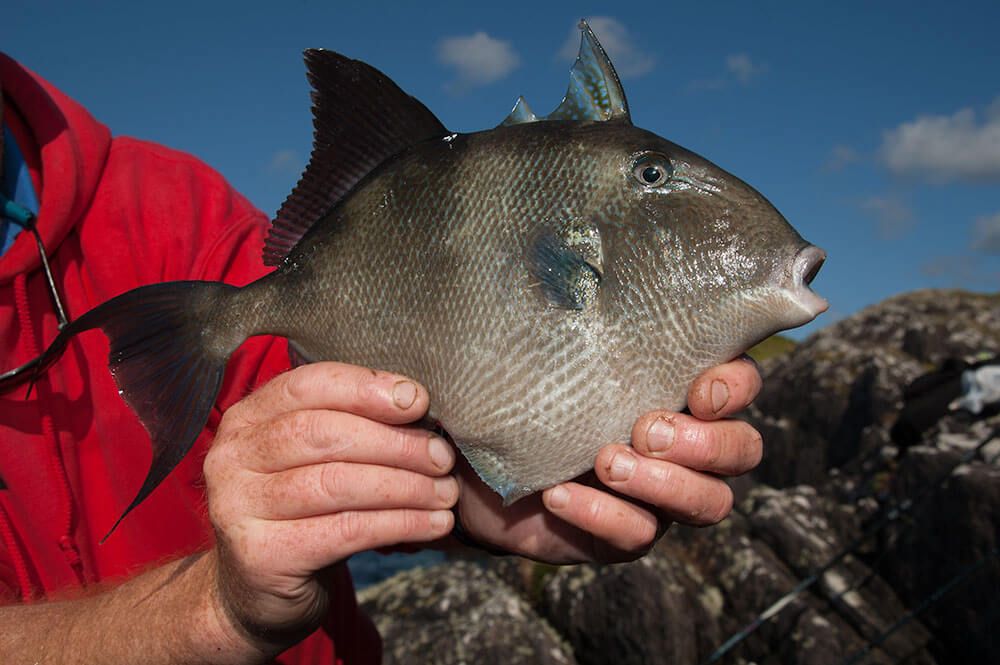
Two decades ago they were rare north of the English Channel with only Devon and Cornwall seeing a few, plus the Welsh coast, but as sea temperatures have lifted and the winter become generally milder, they have extended their range and are now found as far north as the Mull of Galloway, plus they are a little more common in the North Sea and occasionally wash up on the Holderness coast in East Yorkshire.
In Ireland the same has occurred. They were once rare visitors but are now almost common along the Cork and Kerry coast and do penetrate as far as Galway and into Donegal.
Their teeth are adept at forcing shellfish such as mussels, limpets and barnacles off the rocks and then crushing them, sifting the good food value from the shell, then discarding the hard shell. They also take crabs again, smashing them up in their mouths and ejecting the shell.
On deeper beaches, they will take up residence around the remnants of small wrecks such as pleasure craft or even old sunken WW2 defence structures. Again, if the wreckage is small individual fish can lay claim to it, but bigger structures can see up to half a dozen triggers take up residence. They won’t wander too far away from the wreckage when feeding.
Other good spots to try are man-made structure such as piers and jetties. These usually have leg supports, be these wooden, concrete or metal, and the triggers will feed in and around these nipping off attached shellfish, but also using this structure as ambush points to take small fish.
They can also be found working the boulders used for the structuring of breakwaters. Again, they often take up residence around an obvious feature such as a bigger boulder that sticks out into the tide, or choose a hole between the boulders, and then work a route either side of this to feed and to defend.
They can also be caught on open coast rock ledges that give in to moderately deep water. You’re looking for channels between the rocks that cut back into the cliffs as the triggers like to claim these as they’re own and feed on the rocky sides taking off the shellfish and barnacles that live there. They can often be seen in the water working the rocky sides if you get some height and look down from above.
On the same ground they may be out off the rocky ledges in water say up to 20-feet deep, again living around larger boulders, rising rock pinnacles or kelp weed beds. Another good spot is if you can locate an obvious rocky shelf or wall.
When you’re fishing from rock ledges, take note of where the lobster pots are. Casting close to the lobster pots or putting baits downtide of where the lobster pots are is a prime spot for triggers. If the pots are freshly baited, all the better. The triggers will pick up the scent of the pot bait and will trace it to source. Smaller triggers, even middle-sized triggers will force their way into lobster pots to give the potter something to deal with when the pot surfaces.
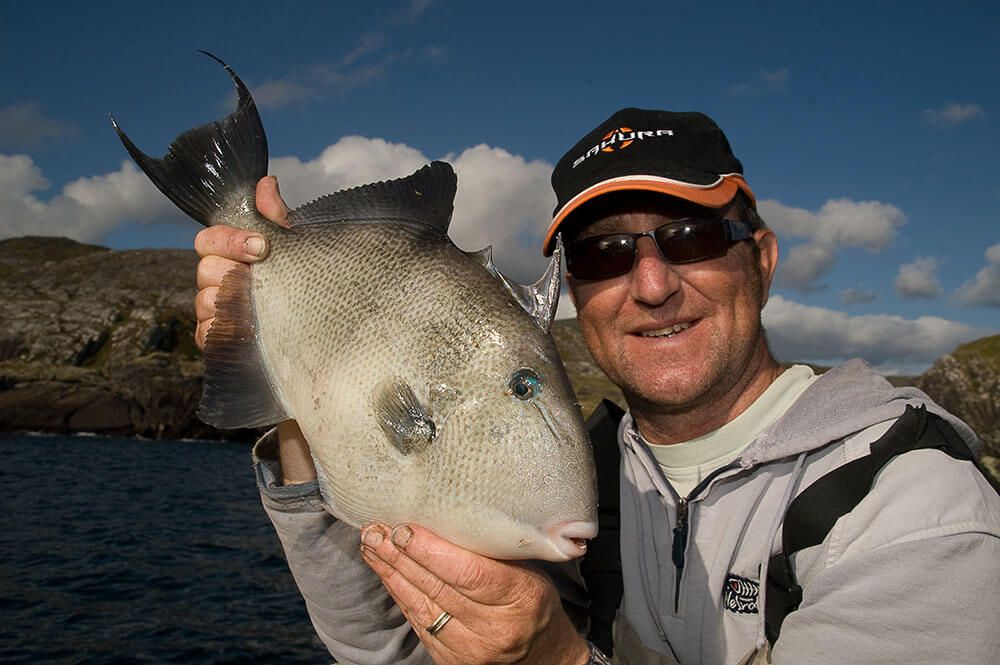
In all situations they are less likely to be caught over low and high-water slack when the flow is minimal. On the outgoing ebb tide, they are always wary of being caught out in shallower water, so this is something to bear in mind. However, in deeper open coast gullies and around weed beds or rock channels, they will continue to feed until the water appreciably shallows and will then move out.
It’s not always quite the same when you’re fishing piers and jetties. If there is a good depth of water, the triggers may stay around the pylons all the time throughout the tide, but it depends on how fast the tide flow is. If the pier or jetty faces the main flow of a fast tide, the fish may only feed either side of slack water. If the jetty or pier is in a bay where the flow is lighter, then they may be present right through the tide or very close by, but only appear to feed when conditions are right staying for maybe an hour or two then moving out again.
They favour warm settled weather patterns and like mainly clear seas with little sediment present. In periods of rougher seas and windy weather they move out to deeper water and will only return when the seas flatten, and the sediment clears.
It doesn’t matter to the trigger whether the sun shines brightly, or the sky is overcast. The only thing to bear in mind is that in bright conditions the fish will seek deeper water, and in cloudy conditions they may be feeding higher in the water.
One thing to look for is a warm wind. Typically, it’s the southwest wind that gives the best conditions with any north in the wind dropping the overall air temperature and this can make a difference. In the right condition’s southerly winds and even an east wind in summer can be warm, and these are the winds to fish triggers in. Light consistent winds from the same quarter are way better than winds that swing in direction.
The ideal rod and reel for fishing off breakwaters, piers and jetties, also from the rock ledges, would be a fast-tapered spinning rod capable of casting up to 3ozs. Matched to a tough 4000 sized fixed spool reel like a Penn Spinfisher or Slammer 3 loaded with 30lb braid makes for a good combination. 30lb braid may seem heavy, but you need to be able to really bully a trigger away from any snags and the more robust 30lb braid allows you to do this.
They have very good eyesight in the clear water, so you do need to add a section of 20lb fluorocarbon, say one and half times the length of the rod. Knot this to the braid using an Albright Knot which will travel through the rod rings cleanly during the fight. As is mentioned so many times, the fluorocarbon is way better than mono for this as it lacks the stretch and is far more abrasion resistant when coming in contact with structure that the triggers head for, also it is not easily seen so disguises the braid.
If you’re fishing from the shore and need to cast a fair way to an obvious underwater structure, then there are two choices.
Casting up to moderate range, say 60-yards or so, then a bass rod rated 2-4ozs and either a multiplier reel such as the Penn 515 Mag3 or a 5000 fixed spool reel is well up to the job. Load the multiplier with 15lb line and a 30lb shock leader, and load the fixed spool with 30lb braid and you can dispense with the leader when casting lead weights of 3ozs or less. For a longer range, then you have little choice but to choose a standard 4-6oz beachcaster, a larger Penn 525 multiplier or similar from Akios or Daiwa and load with 20lb mono and a 60lb shock leader. Another good long-range choice would be a longer 14 to 15ft Euro style beachcaster matched to a 7000, 7500 or 8000 sized fixed spool reels loaded with 30lb braid and a 60lb braid leader.
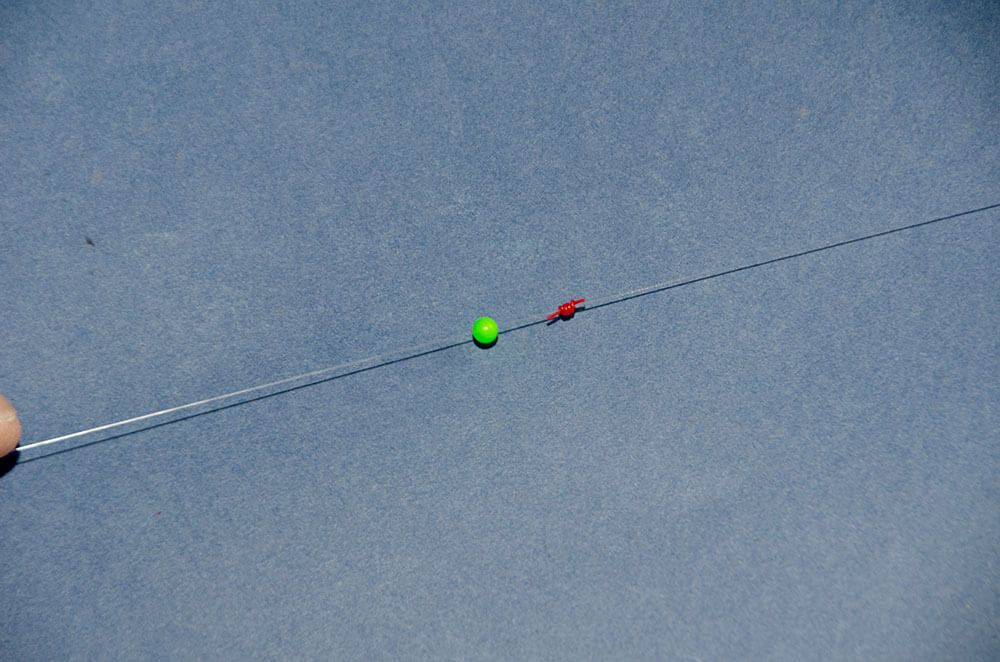
1 – On to the shock leader when using braid, or the main mono line, tie on a Powergum stop knot and slide on a size 5mm bead.
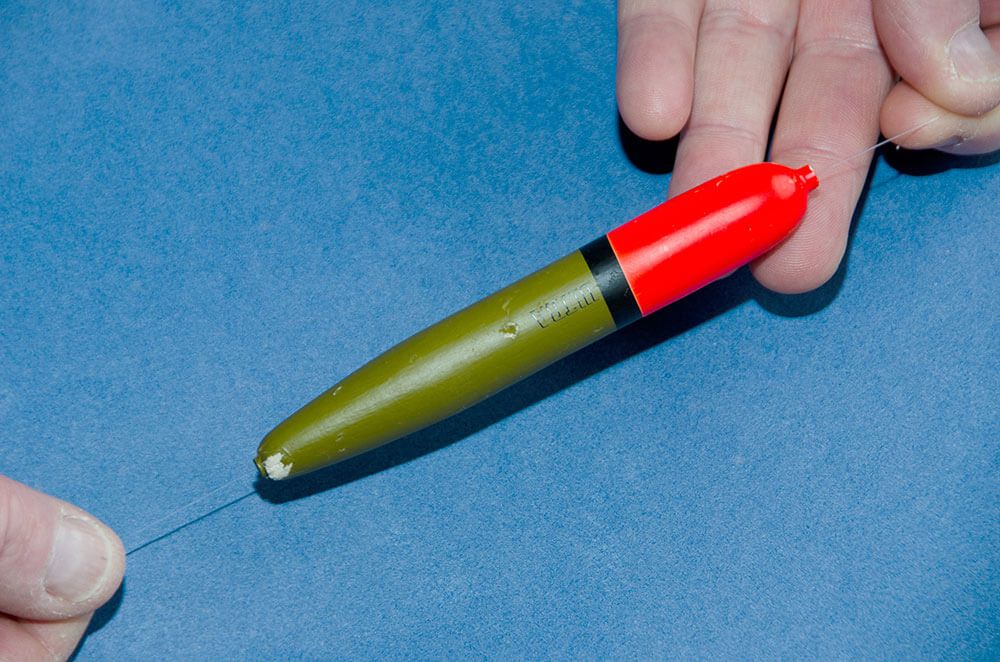
2 – Below the bead slide on cigar shaped float about 5 to 8-inches long.
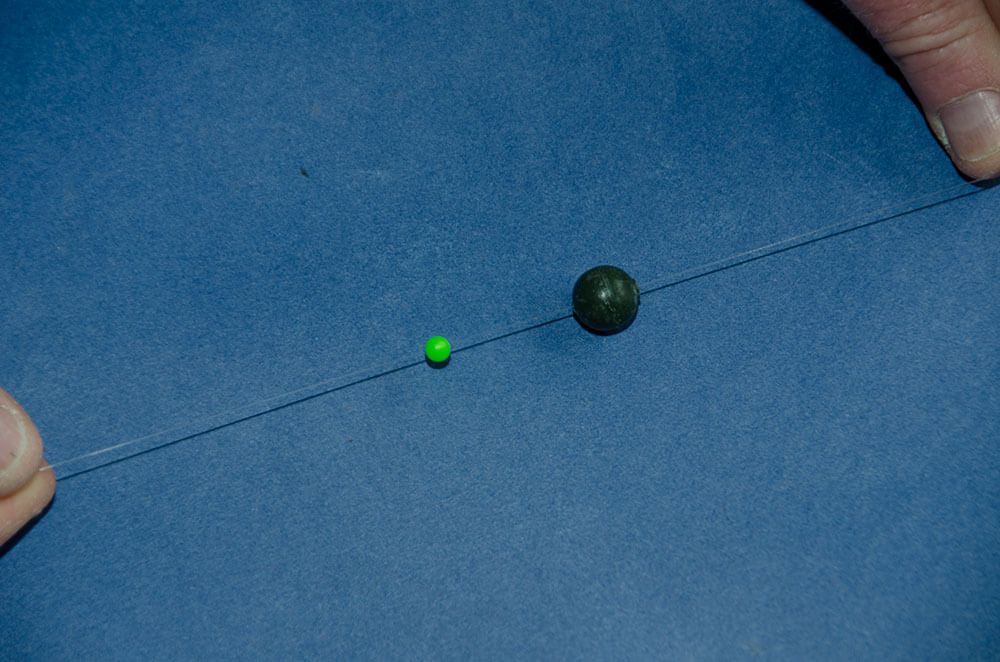
3 – Slide on a round ball-weight between a quarter and one ounce, enough to fully load and cock the float, and another 5mm bead. To the end of the shock leader tie on a size 6 rolling swivel. To the free eye of the swivel tie on a short 30-inch length of 20lb Fluorocarbon.
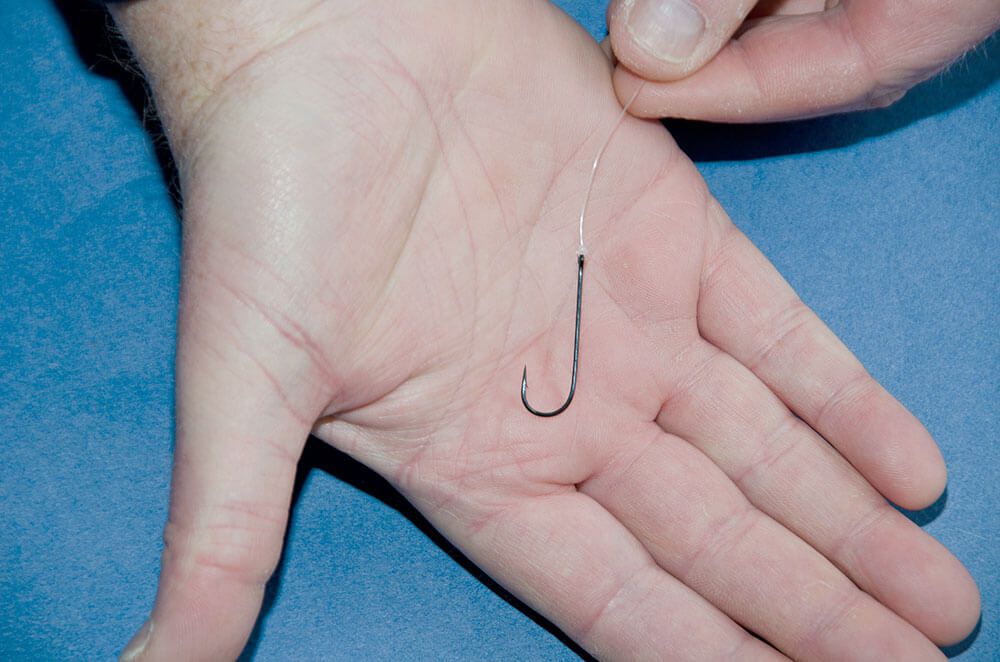
4 – Finish with a size 2 Kamasan B940 Aberdeen hook.
You can set the depth the bait fishes at by simply sliding the stop knot up and down on the leader. Most triggers are caught in water less than 12-feet deep, so the leader and hook length is usually enough. If not just increase the length of the leader a little.
The float rig is the one to choose for fishing piers, jetties, breakwaters and the rocky coast marks. You can set the depth quickly to find the depth the fish are feeding at. Also, the float will work in and out around the structure and seeks out all the hidey holes where the triggers may be feeding. Also, suspending a bait above the seabed some distance also helps to avoid the worst of the snags.
Try to choose a float that’s not too big in size to minimise the buoyancy and use a weight that’s heavy enough to just keep the top inch of the float above the surface. It doesn’t matter if the float occasionally dips just under. What you’re looking for is the float fully disappearing down into the depths. Triggers can play with baits, but when they are feeding confidently the float just goes down like a stone.
If you need to cast away from you a short distance, a black topped float is easier to see than a yellow or red topped float is, especially if the water is a little choppy. If you’re fishing almost directly under the rod tip, then it doesn’t make too much difference.
The choice of the Aberdeen hook is also important. Longer shank Aberdeen patterns give some protection from the teeth of the trigger. They tend not to take bait too far in using the techniques described and will tend to be hooked in the front of the mouth, especially with the float and drop-down ledger tackle.
Occasionally, try lifting and dropping the bait by lifting the rod tip up a few inches and dropping it back, or sliding the float across the surface a few inches. This gives the bait some movement and will often draw a take when a static bait will not.
When fishing this method, make sure you use an old battered lead with no surface flash, or dull down any new leads by soaking them in vinegar. This can make a big difference in getting bites from triggers when they are unsure.
Here’s how to tie it.
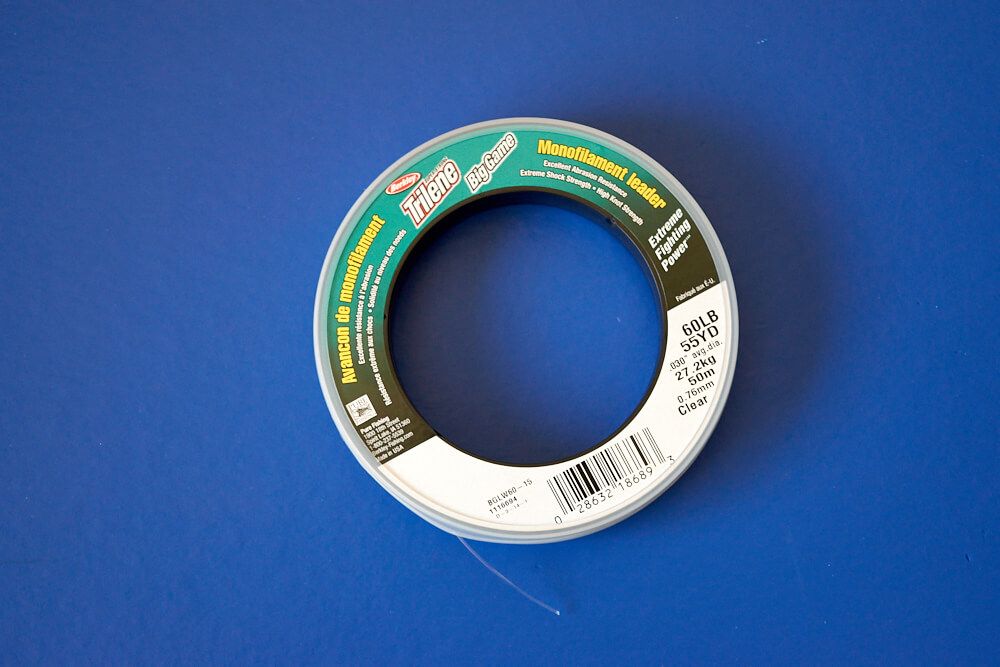
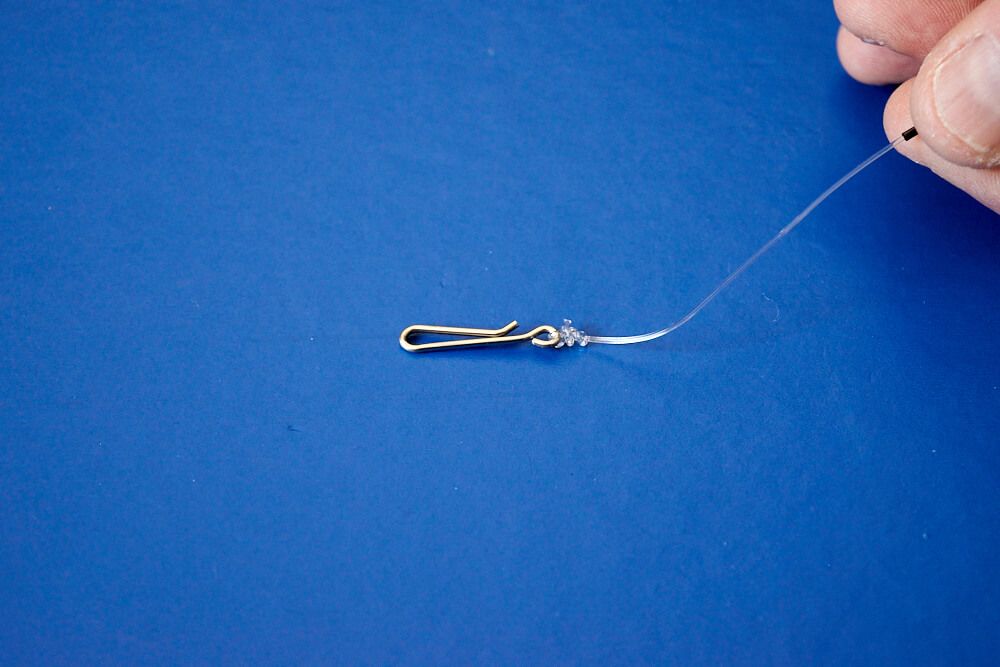
1 – Take a 46-inch length of 60lb rig body line. At one end tie on a Gemini lead link.
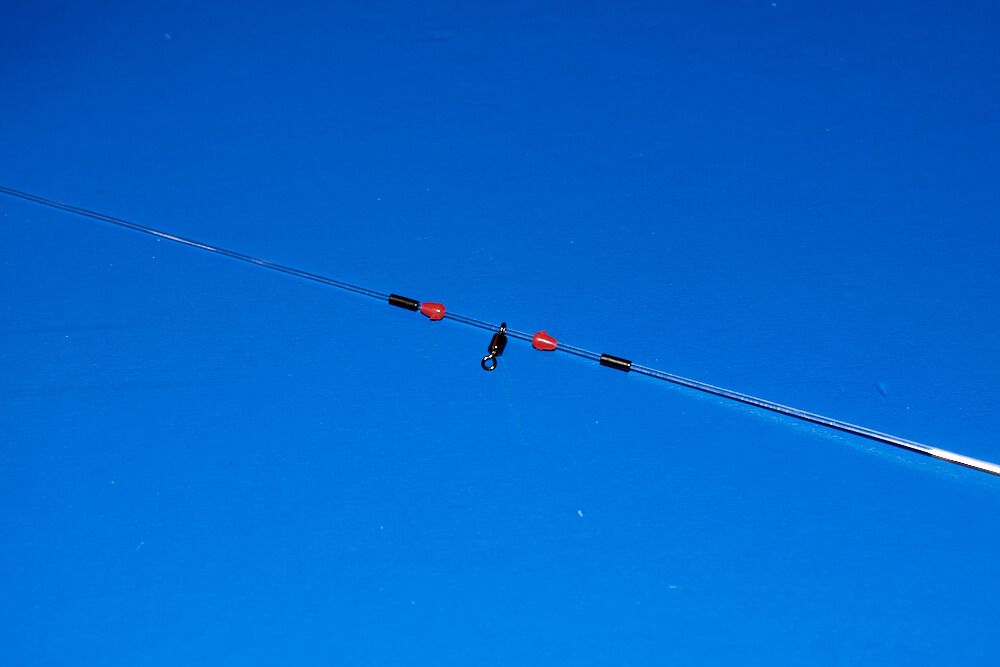
2 – Slide on a rig crimp, followed by a 3mm rig bead, a size 10 rolling swivel, and another bead and crimp.
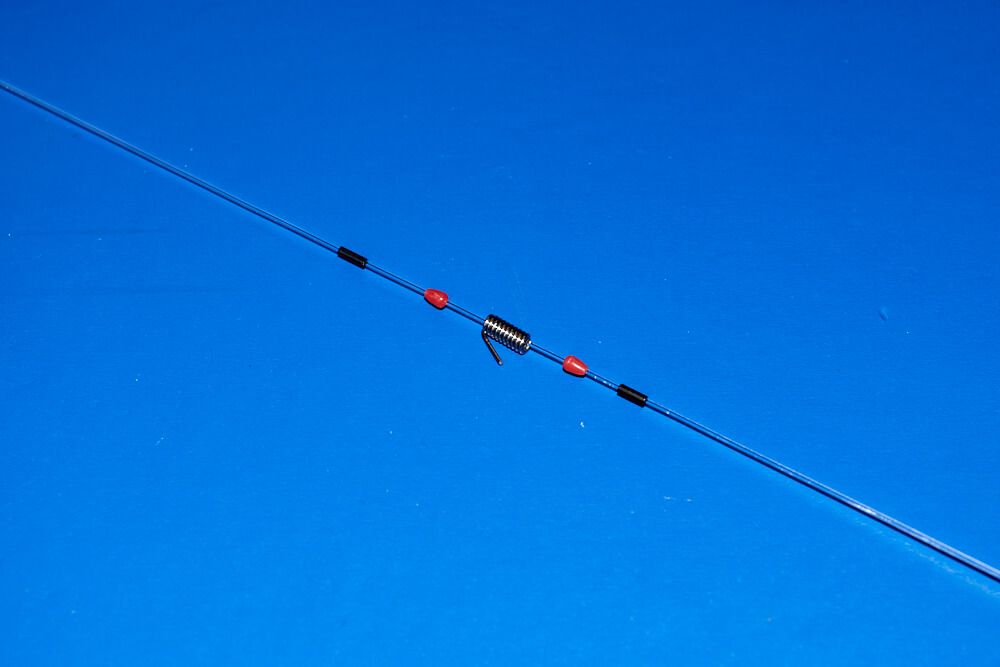
3 – Above these add another crimp, a rig bead and an inverted SALT bait clip. The bait clip needs to be slid on to the rig body line upside down with the hook end of the clip facing upwards.
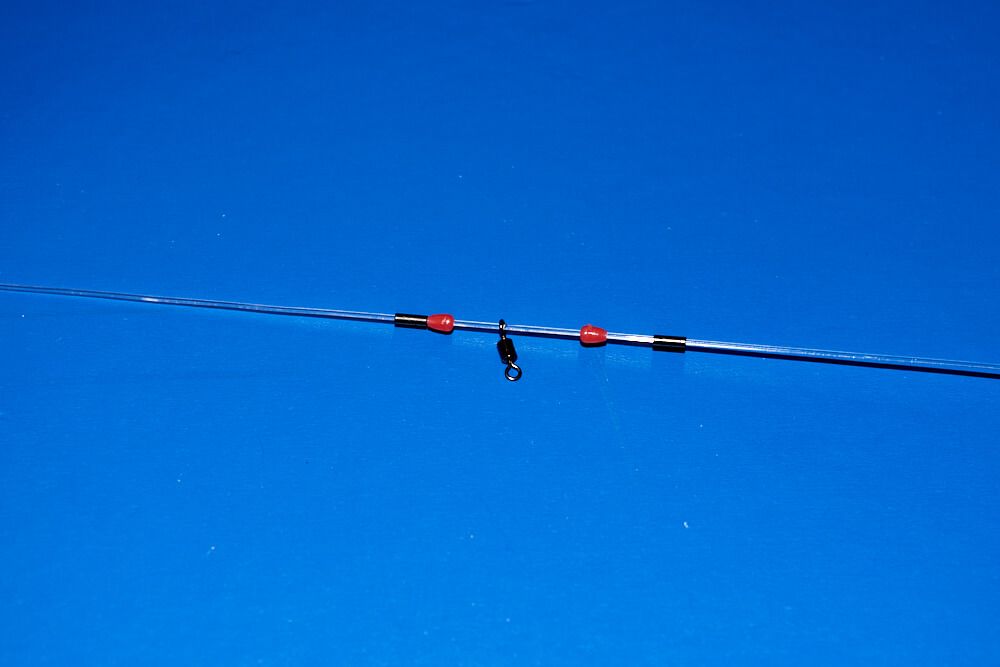
4 – Slide on a rig crimp, followed by a 3mm rig bead, a size 10 rolling swivel, and another bead and crimp.
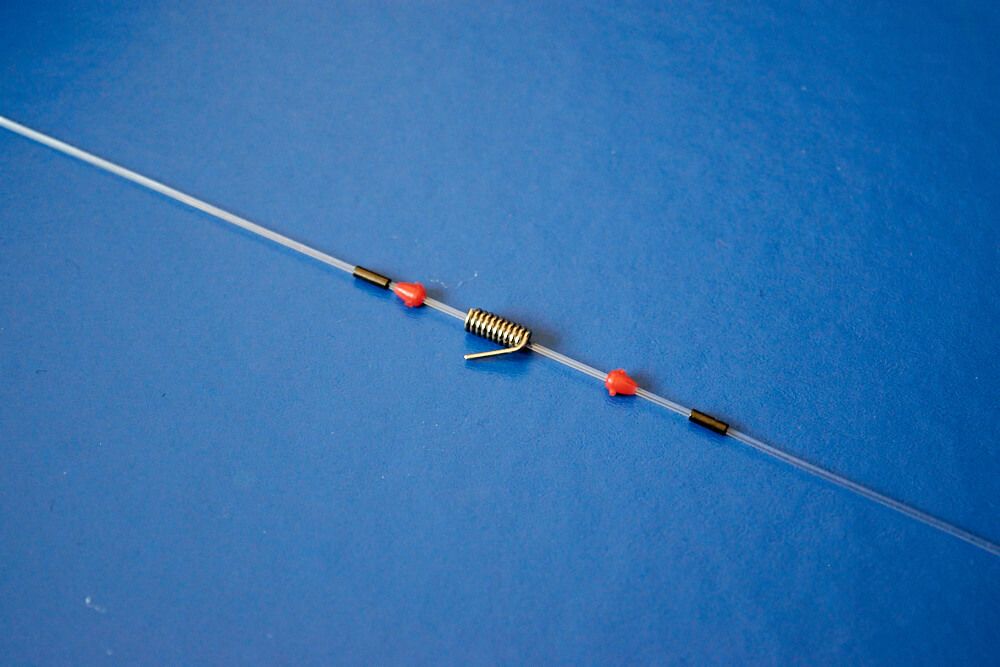
5 – Slide on a crimp, bead and inverted SALT bait clip. Leave all the above components free to slide on the rig body line for the moment.
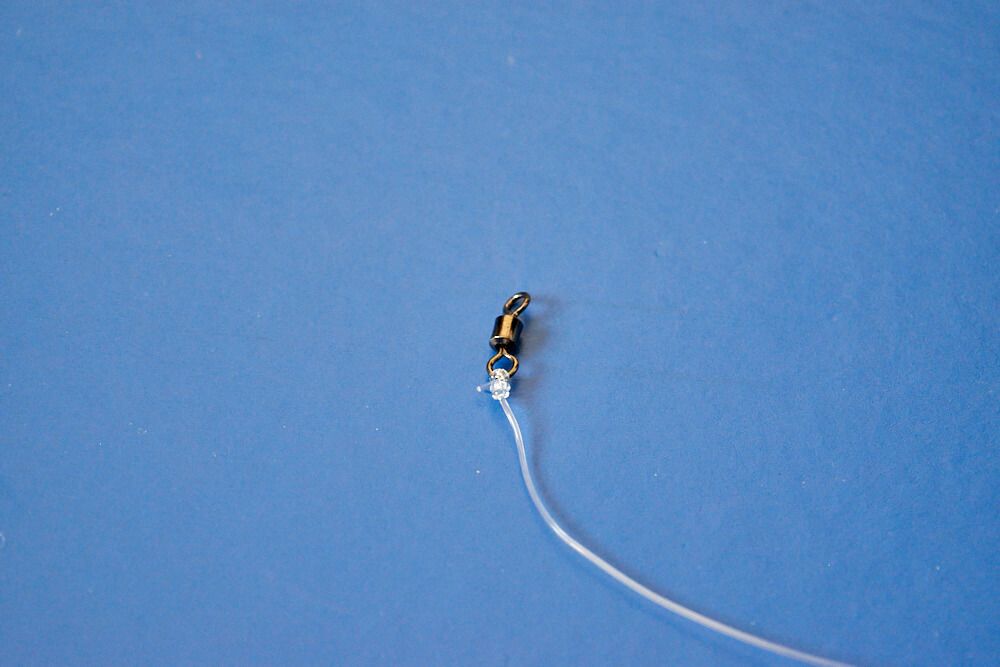
6 – Complete the main rig by adding a size 4 rolling swivel at the top.
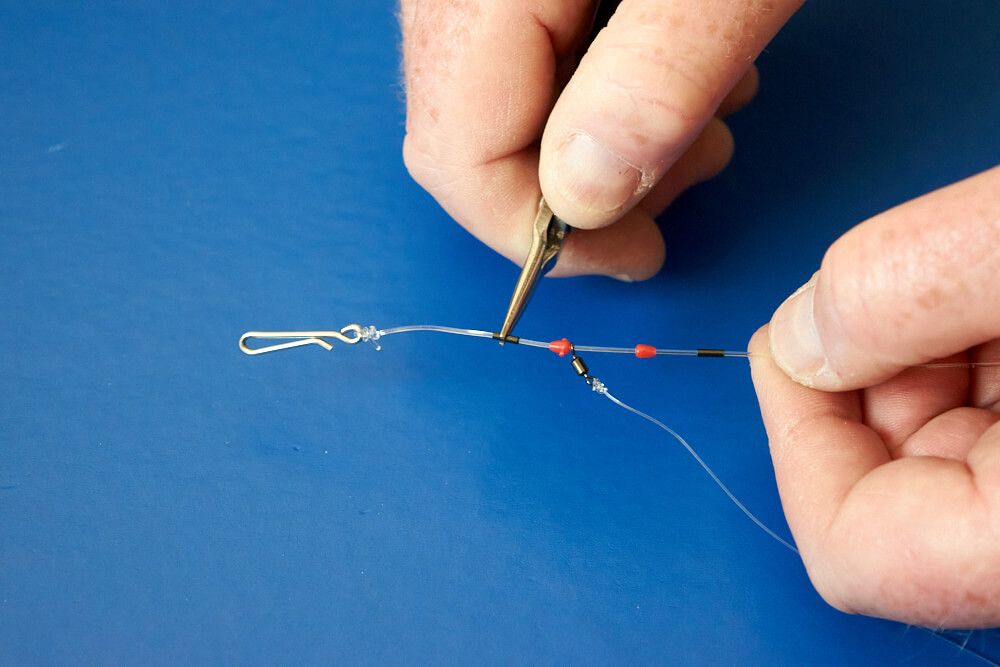
7 – Now crimp the first snood swivel in place 1-inch above the lead link. Leave enough room between the two crimps and beads for the swivel to freely turn.
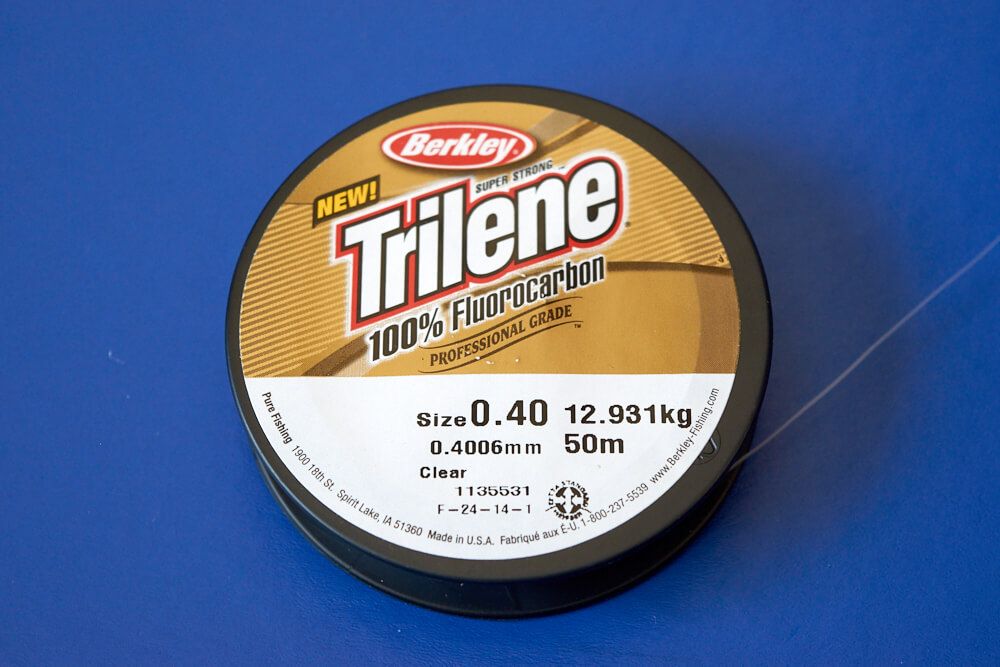
8 – The hook links need to be 20lb to 25lb mono or fluorocarbon between 12 and 18 inches long.
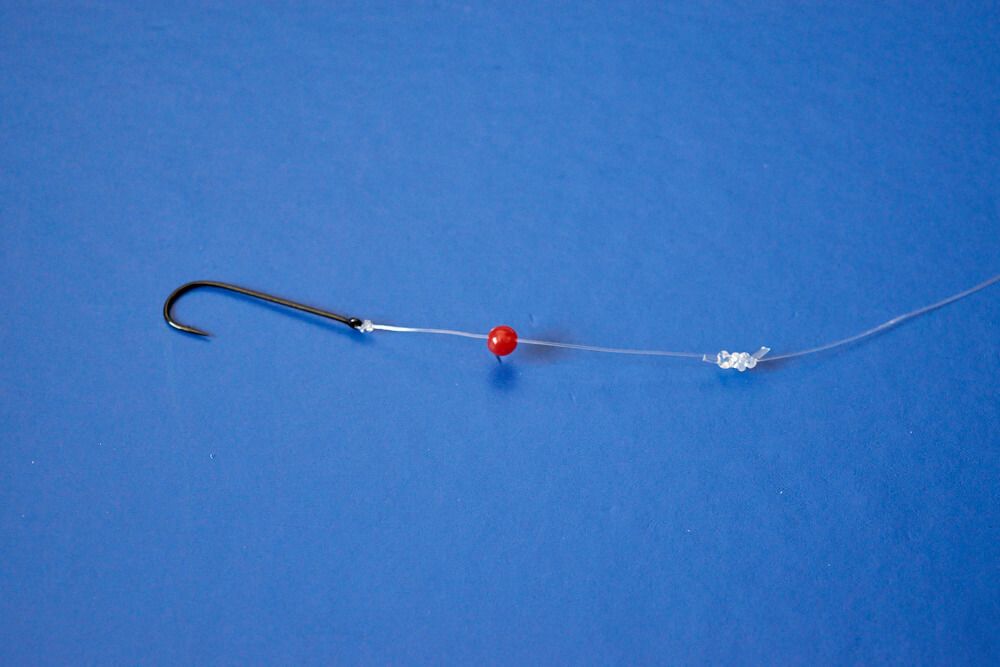
9 – Slide on a 5mm rig bead to act as a bait stop, and tie on a size 2 Kamasan B940 Aberdeen hook. Above the 5mm bead tie in a 5-turn Powergum stop knot.
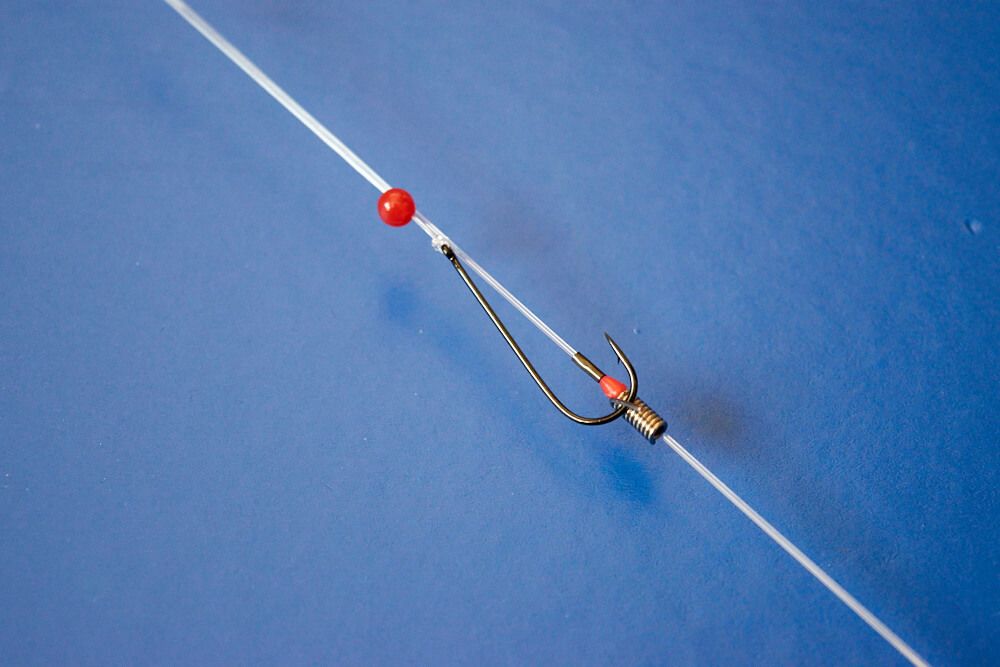
10 – Position the hook in the bait clip and slide the bait clip up the rig until the hook snood comes just tight. Slide the crimp and bead up towards the bait clip and crimp it in place just below the bait clip. If you just lightly nip the crimp to the mono, it allows the clip to be adjusted at any time and to slide under heavy pressure to avoid snood stretch during the cast.
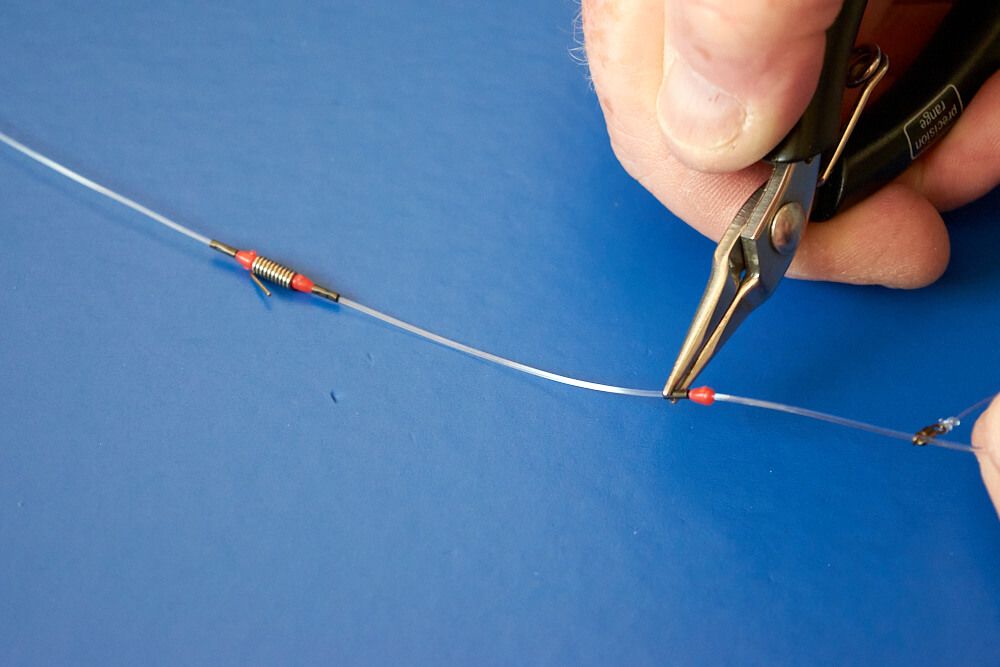
11 – The second snood swivel needs crimping about 3-inches above the first bait clip. Add the hook length and hook with rubber rig stop, sequin and hook added.
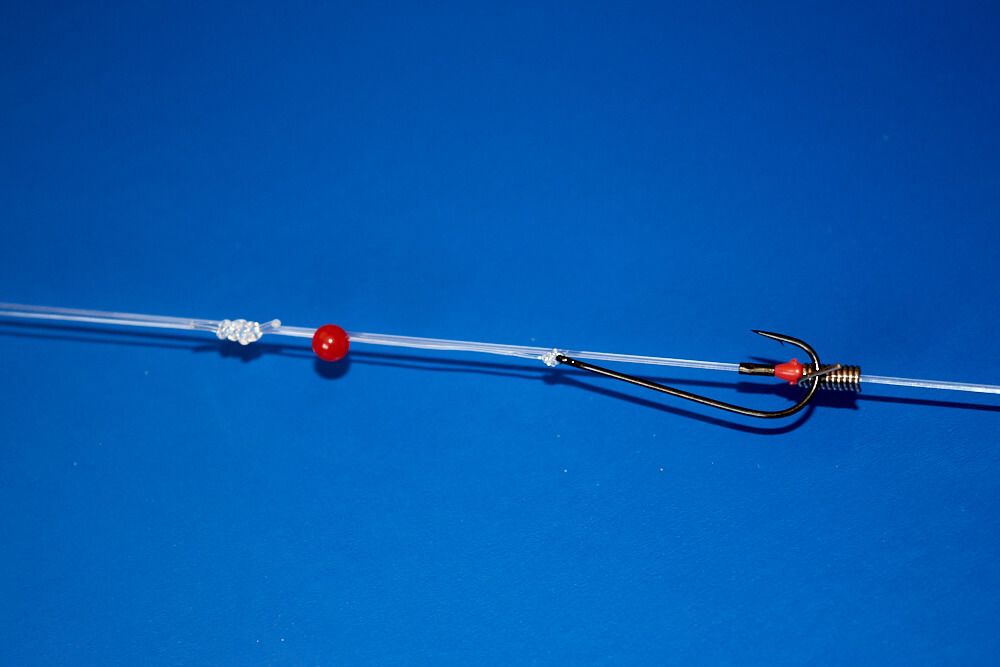
13. Position the bait clip and crimp in place as before. This positions the top hook inside the bait clip just a couple of inches or so below the main size 4 connector swivel.
There is no real need for bait stops above the hook on this rig as the air pressure during the cast is forcing the bait towards the hook, but it helps give a neater bait presentation, and especially when using small delicate ragworm and lug baits.
Aim to cast this rig as near to the structure you’re targeting as possible. Also think about the tide direction. Try to get the bait just uptide of the structure so that the scent from the baits washes down to the fish. You’re basically looking to draw the fish off the structure to the baits, but they won’t travel too far, so casting accuracy can be key here.
When using the drop net, play the fish fully out until they are tired, then draw them in on the surface towards the net and once over the top, lift them steadily up so they drop fully into the depth of the net. This is the way to return them, too, by placing them in the drop net, dropping this back to sea level and letting the trigger swim free. Never drop them from height as this can cause obvious damage to them.
Landing nets are also advised when fishing from rocks and boats too.
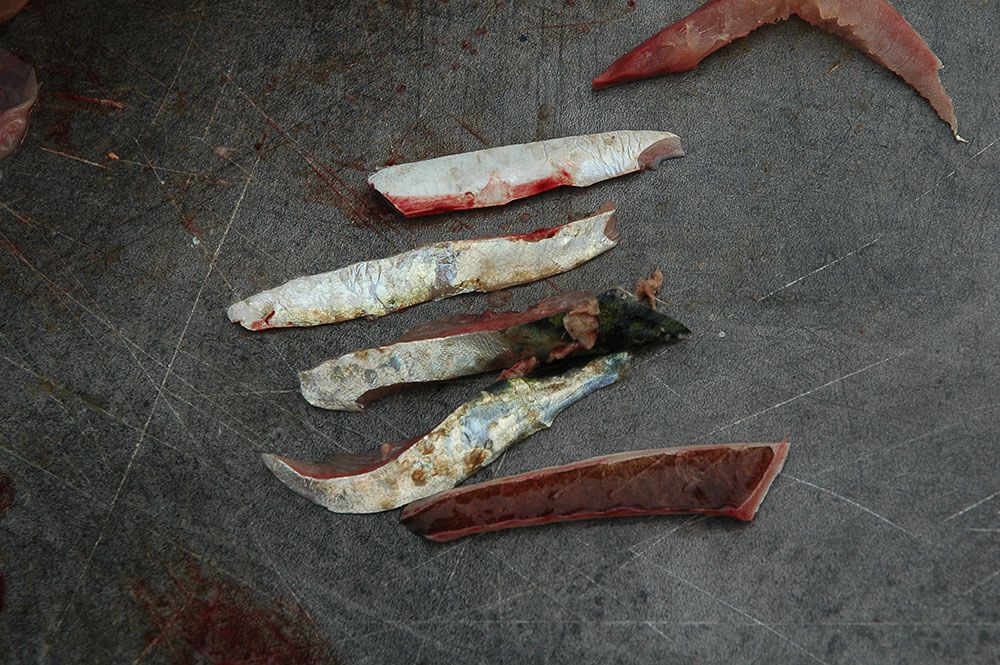
The best baits for general float fishing are crab, lugworm and mackerel strip. Peeler crab needs to be cut across the body to form two or three small sausage shaped baits when bound to the hook with bait elastic. It also pays to hide the hook point by sliding a peeled claw or leg over the hook as this can induce more bites. Small hardback crabs will also take triggers when rock, breakwater and pier fishing. To present these, leave the legs on the crab and just pass the hook through both the belly and the back of the crab just in from the back edge of the body.
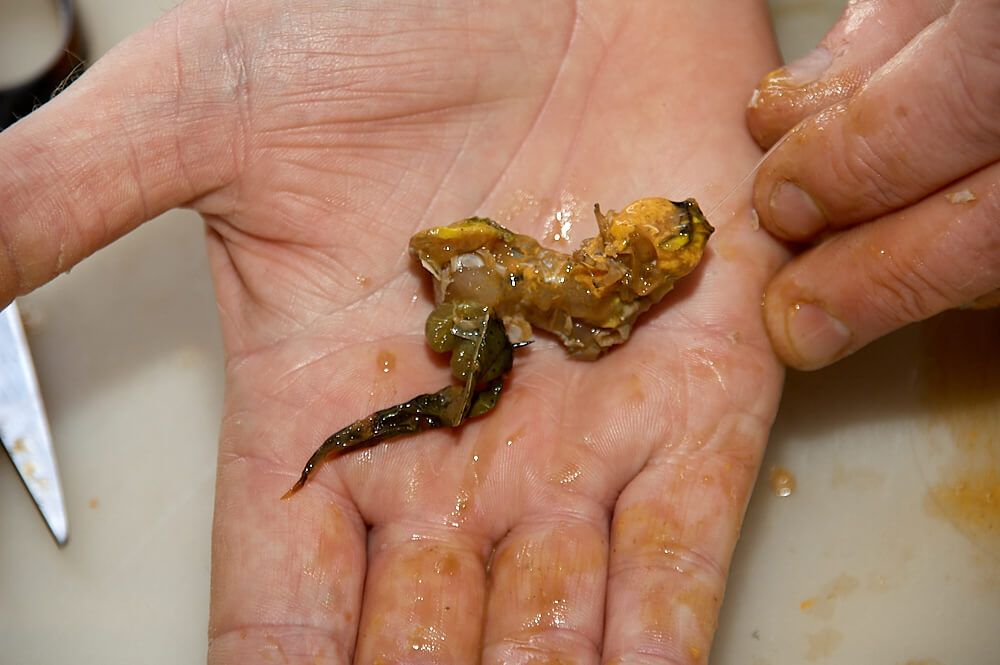
Lugworm should be just a small worm or half a bigger worm fed on to the hook to fully hide the hook point and shank. Mackerel strips need to be cut about 1.5-inches long and a half inch wide. Pass the hook through the skin side at one end, pull it through, then bring the hook back through skin from the flesh side slightly lower down to expose the hook.
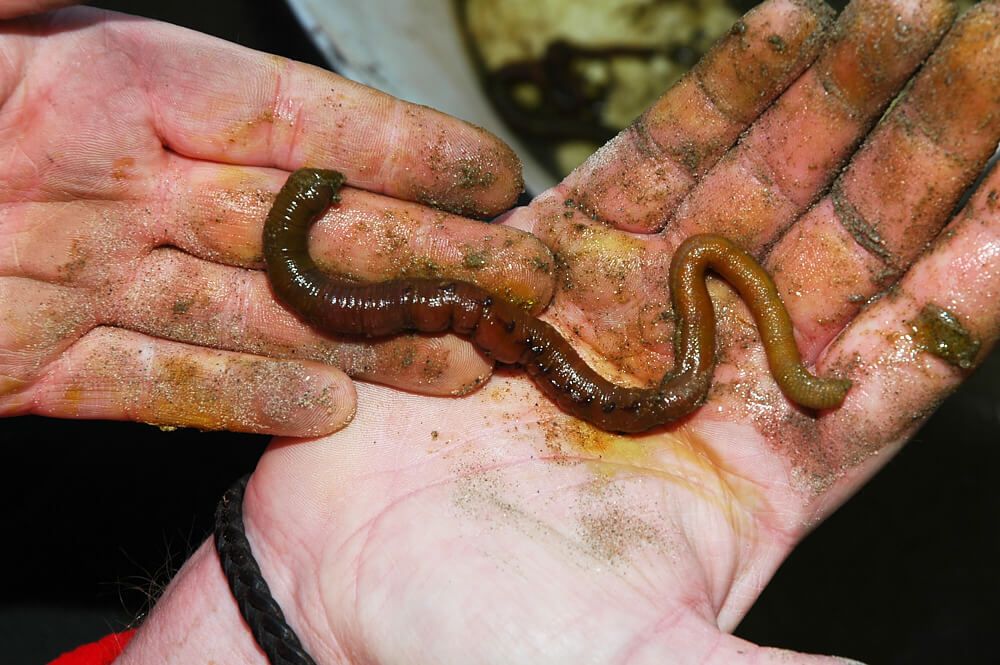
Other baits that work are mussel, limpet, sandeel sections and ragworm.
Groundbait does not need to be complicated. A simple soup of smashed up mackerel with a little animal feed bran (cheap from pet supplies) and a little pilchard oil is all you need. If you can’t get pilchard oil use a tin of sardines or mackerel in sunflower oil.
The best way to distribute this is to use an old soup spoon or ladle. Throw this into the water a few times to get things started, then an additional spoon full every minute or two until you see the fish coming up as the soup drops through the water column. Make sure you keep adding the soup a little at a time but continually. If you notice the triggers stop feeding or disappear, then throw more in until they return. This really is the key, to keep the groundbait fresh and going in on a consistent basis. Often you won’t even know a trigger is there until you get the groundbait going in.
The way to fish these marks is to anchor uptide of the ground you intend to fish. You need to get groundbait down on the ground and attaching a more solid mix of bran, smashed up mackerel and pilchard oil in a medium sized plastic tub with plenty of holes drilled in it and attached to the anchor chain will be enough. Don’t use mesh bags as fish like bream and dogfish will tear through the mesh and all your groundbait will quickly be lost.
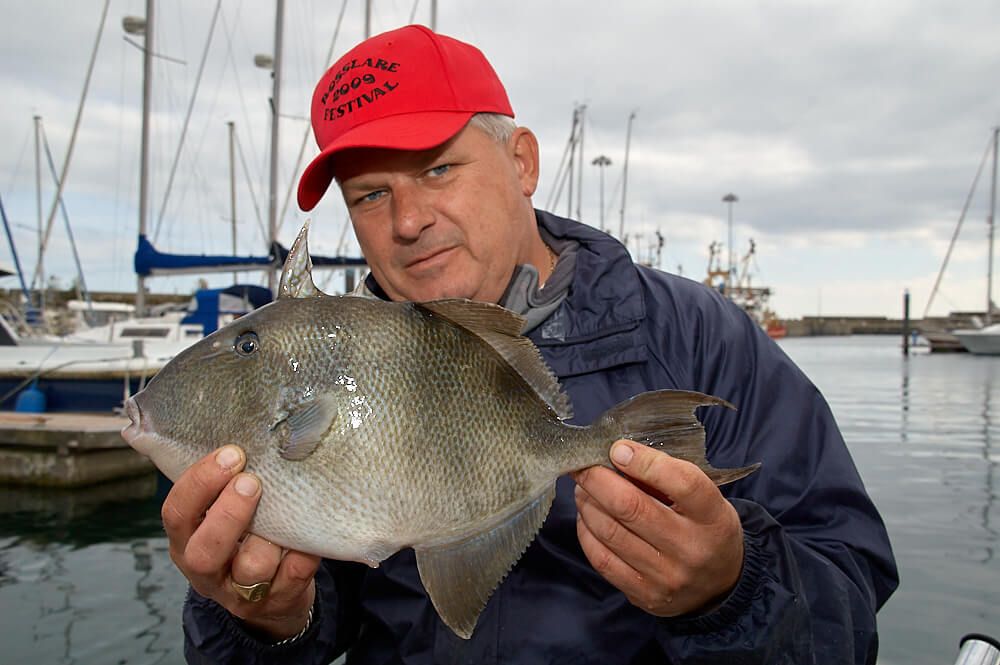
The best baits remain either crab or mackerel strip, but a whole prawn can be very effective, too.
This same tactic also works well if you watch for lobster pot crews refreshing their pots. The new bait they add to the pot will draw the triggers into the general area. Anchoring up near to the lobster pots is a good and quick way to find the triggerfish shoals.
About the triggerfish
The triggerfish is a relatively new annual target for UK sea anglers, as prior to the turn of the millennium, they were fairly rare in British and Irish waters. It was just the occasional fish caught by accident. That said, they have been caught and recorded from the 1950’s on, and probably previous to that too, just not registered as such.There are around 40 different triggerfish species around the world, the majority in tropical and subtropical waters. The UK triggerfish is called the Grey Triggerfish. Their nickname is “File fish” as their skin is very abrasive and feels like a file or rasp.
With so many UK anglers now targeting either an annual or lifetime species target number, the triggerfish has become of great interest and this coincides with an increase in their numbers due to climate change and warming sea temperatures.
How to identify a triggerfish
It’s almost impossible to confuse the triggerfish with any other species. It has an ovalised deep body, a small eye and small mouth, but the mouth has sharp incisor type teeth it uses to prise shellfish from their grip on the rocks.The dorsal first fin has three spines. The first is sharp and strong, and the second and third fit into a groove in the fish’s back that locks the whole first dorsal into an erect position as a defence mechanism. Pressing on the second spine disengages the whole dorsal, hence the name triggerfish. The second dorsal and the anal fins are both large. The tail fin has long extensions which are another giveaway as to the ID of a triggerfish. There is also a sharp spine where the pelvic fins should be, and this again is part of the fish’s protection system.
Triggers can vary in colour, mainly they are an olive brown or greyish, but they can have blue on their flanks that catch the light and occasionally a hint of yellow about the head. The dorsal and anal fins also carry a basal blue lines.
Even in warmer seas triggers rarely grow more than 8lbs in weight. Fish near this weight have been recorded caught commercially in inshore nets in the UK, but the majority are well under 4lbs in weight and average between 1.5lb and 3.5lbs.
A known fact is that triggers are very water temperature sensitive and those staying late in UK waters are often caught out by a sudden drop in inshore temperatures and they will often wash up on the beach either dead or in a near comatose state.

Triggerfish distribution
Triggerfish are classed as an offshore open ocean species worldwide and can be found living under floating weed growth and floating wreckage travelling the ocean at the whim of the wind and sea currents. In the UK they frequent the immediate inshore band and in depths of less than 25-metres generally.Two decades ago they were rare north of the English Channel with only Devon and Cornwall seeing a few, plus the Welsh coast, but as sea temperatures have lifted and the winter become generally milder, they have extended their range and are now found as far north as the Mull of Galloway, plus they are a little more common in the North Sea and occasionally wash up on the Holderness coast in East Yorkshire.
In Ireland the same has occurred. They were once rare visitors but are now almost common along the Cork and Kerry coast and do penetrate as far as Galway and into Donegal.
Triggerfish diet
They eat mainly small crabs, shrimps, prawns and shellfish. But new evidence suggests, at times, they will also take small fish when these are plentiful.Their teeth are adept at forcing shellfish such as mussels, limpets and barnacles off the rocks and then crushing them, sifting the good food value from the shell, then discarding the hard shell. They also take crabs again, smashing them up in their mouths and ejecting the shell.
Shore fishing
Types of marks to catch triggerfish
When inshore they favour shallow reef ground and weed beds. The rougher the ground is, the better! They have a habit of being somewhat territorial and will select a larger than average boulder which they use as their main home and will defend the immediate area around it with some vigour.On deeper beaches, they will take up residence around the remnants of small wrecks such as pleasure craft or even old sunken WW2 defence structures. Again, if the wreckage is small individual fish can lay claim to it, but bigger structures can see up to half a dozen triggers take up residence. They won’t wander too far away from the wreckage when feeding.
Other good spots to try are man-made structure such as piers and jetties. These usually have leg supports, be these wooden, concrete or metal, and the triggers will feed in and around these nipping off attached shellfish, but also using this structure as ambush points to take small fish.
They can also be found working the boulders used for the structuring of breakwaters. Again, they often take up residence around an obvious feature such as a bigger boulder that sticks out into the tide, or choose a hole between the boulders, and then work a route either side of this to feed and to defend.
They can also be caught on open coast rock ledges that give in to moderately deep water. You’re looking for channels between the rocks that cut back into the cliffs as the triggers like to claim these as they’re own and feed on the rocky sides taking off the shellfish and barnacles that live there. They can often be seen in the water working the rocky sides if you get some height and look down from above.
On the same ground they may be out off the rocky ledges in water say up to 20-feet deep, again living around larger boulders, rising rock pinnacles or kelp weed beds. Another good spot is if you can locate an obvious rocky shelf or wall.
When you’re fishing from rock ledges, take note of where the lobster pots are. Casting close to the lobster pots or putting baits downtide of where the lobster pots are is a prime spot for triggers. If the pots are freshly baited, all the better. The triggers will pick up the scent of the pot bait and will trace it to source. Smaller triggers, even middle-sized triggers will force their way into lobster pots to give the potter something to deal with when the pot surfaces.

Picking the right tides
Like so many fish they will come on the feed during the flood tide. This is usually when the tide has picked up a little and there is some flow in the water. That said, they do not like fast flowing water generally, preferring a gentler to moderate flow and will seek out areas of slack water if there is a definite tide run.In all situations they are less likely to be caught over low and high-water slack when the flow is minimal. On the outgoing ebb tide, they are always wary of being caught out in shallower water, so this is something to bear in mind. However, in deeper open coast gullies and around weed beds or rock channels, they will continue to feed until the water appreciably shallows and will then move out.
It’s not always quite the same when you’re fishing piers and jetties. If there is a good depth of water, the triggers may stay around the pylons all the time throughout the tide, but it depends on how fast the tide flow is. If the pier or jetty faces the main flow of a fast tide, the fish may only feed either side of slack water. If the jetty or pier is in a bay where the flow is lighter, then they may be present right through the tide or very close by, but only appear to feed when conditions are right staying for maybe an hour or two then moving out again.
Weather patterns
Triggerfish are caught in daylight, never darkness when they go comatose and literally sleep a little, much like some wrasse do.They favour warm settled weather patterns and like mainly clear seas with little sediment present. In periods of rougher seas and windy weather they move out to deeper water and will only return when the seas flatten, and the sediment clears.
It doesn’t matter to the trigger whether the sun shines brightly, or the sky is overcast. The only thing to bear in mind is that in bright conditions the fish will seek deeper water, and in cloudy conditions they may be feeding higher in the water.
One thing to look for is a warm wind. Typically, it’s the southwest wind that gives the best conditions with any north in the wind dropping the overall air temperature and this can make a difference. In the right condition’s southerly winds and even an east wind in summer can be warm, and these are the winds to fish triggers in. Light consistent winds from the same quarter are way better than winds that swing in direction.
Triggerfish tackle
Triggerfish tackle is dictated by the type of ground you’re fishing and to some extent whether you need to cast a fair way.The ideal rod and reel for fishing off breakwaters, piers and jetties, also from the rock ledges, would be a fast-tapered spinning rod capable of casting up to 3ozs. Matched to a tough 4000 sized fixed spool reel like a Penn Spinfisher or Slammer 3 loaded with 30lb braid makes for a good combination. 30lb braid may seem heavy, but you need to be able to really bully a trigger away from any snags and the more robust 30lb braid allows you to do this.
They have very good eyesight in the clear water, so you do need to add a section of 20lb fluorocarbon, say one and half times the length of the rod. Knot this to the braid using an Albright Knot which will travel through the rod rings cleanly during the fight. As is mentioned so many times, the fluorocarbon is way better than mono for this as it lacks the stretch and is far more abrasion resistant when coming in contact with structure that the triggers head for, also it is not easily seen so disguises the braid.
If you’re fishing from the shore and need to cast a fair way to an obvious underwater structure, then there are two choices.
Casting up to moderate range, say 60-yards or so, then a bass rod rated 2-4ozs and either a multiplier reel such as the Penn 515 Mag3 or a 5000 fixed spool reel is well up to the job. Load the multiplier with 15lb line and a 30lb shock leader, and load the fixed spool with 30lb braid and you can dispense with the leader when casting lead weights of 3ozs or less. For a longer range, then you have little choice but to choose a standard 4-6oz beachcaster, a larger Penn 525 multiplier or similar from Akios or Daiwa and load with 20lb mono and a 60lb shock leader. Another good long-range choice would be a longer 14 to 15ft Euro style beachcaster matched to a 7000, 7500 or 8000 sized fixed spool reels loaded with 30lb braid and a 60lb braid leader.
Rigs and techniques for catching triggerfish
Float fishing
There are two rigs that work well for triggers. The first is a float set up for use with the spinning rod.
1 – On to the shock leader when using braid, or the main mono line, tie on a Powergum stop knot and slide on a size 5mm bead.

2 – Below the bead slide on cigar shaped float about 5 to 8-inches long.

3 – Slide on a round ball-weight between a quarter and one ounce, enough to fully load and cock the float, and another 5mm bead. To the end of the shock leader tie on a size 6 rolling swivel. To the free eye of the swivel tie on a short 30-inch length of 20lb Fluorocarbon.

4 – Finish with a size 2 Kamasan B940 Aberdeen hook.
You can set the depth the bait fishes at by simply sliding the stop knot up and down on the leader. Most triggers are caught in water less than 12-feet deep, so the leader and hook length is usually enough. If not just increase the length of the leader a little.
The float rig is the one to choose for fishing piers, jetties, breakwaters and the rocky coast marks. You can set the depth quickly to find the depth the fish are feeding at. Also, the float will work in and out around the structure and seeks out all the hidey holes where the triggers may be feeding. Also, suspending a bait above the seabed some distance also helps to avoid the worst of the snags.
Try to choose a float that’s not too big in size to minimise the buoyancy and use a weight that’s heavy enough to just keep the top inch of the float above the surface. It doesn’t matter if the float occasionally dips just under. What you’re looking for is the float fully disappearing down into the depths. Triggers can play with baits, but when they are feeding confidently the float just goes down like a stone.
If you need to cast away from you a short distance, a black topped float is easier to see than a yellow or red topped float is, especially if the water is a little choppy. If you’re fishing almost directly under the rod tip, then it doesn’t make too much difference.
The choice of the Aberdeen hook is also important. Longer shank Aberdeen patterns give some protection from the teeth of the trigger. They tend not to take bait too far in using the techniques described and will tend to be hooked in the front of the mouth, especially with the float and drop-down ledger tackle.
Occasionally, try lifting and dropping the bait by lifting the rod tip up a few inches and dropping it back, or sliding the float across the surface a few inches. This gives the bait some movement and will often draw a take when a static bait will not.
Ledger fishing
The second is a simple paternoster rig that gets the bait down near the seabed and holds it in place when dropping straight down from piers, breakwaters and jetties. This is a good rig off the rocks too, if there is more depth and you’re fishing a deep rocky channel.- To the leader tie on a strong size 4 three-way swivel.
- To the lower eye tie on 24-inches of lighter 12/15lb line.
- Tie on a small 1oz to 2oz weight to the lighter line.
- To the middle eye of the swivel tie on 15-inches of 20lb fluorocarbon.
- To the fluorocarbon tie on a size 2 Kamasan B940 Aberdeen hook.
When fishing this method, make sure you use an old battered lead with no surface flash, or dull down any new leads by soaking them in vinegar. This can make a big difference in getting bites from triggers when they are unsure.
2-HOOK CLIPPED UP RIG
When using a beachcaster, due to the casting distance needed, a standard 2-hook clipped up flapper rig is best.Here’s how to tie it.


1 – Take a 46-inch length of 60lb rig body line. At one end tie on a Gemini lead link.

2 – Slide on a rig crimp, followed by a 3mm rig bead, a size 10 rolling swivel, and another bead and crimp.

3 – Above these add another crimp, a rig bead and an inverted SALT bait clip. The bait clip needs to be slid on to the rig body line upside down with the hook end of the clip facing upwards.

4 – Slide on a rig crimp, followed by a 3mm rig bead, a size 10 rolling swivel, and another bead and crimp.

5 – Slide on a crimp, bead and inverted SALT bait clip. Leave all the above components free to slide on the rig body line for the moment.

6 – Complete the main rig by adding a size 4 rolling swivel at the top.

7 – Now crimp the first snood swivel in place 1-inch above the lead link. Leave enough room between the two crimps and beads for the swivel to freely turn.

8 – The hook links need to be 20lb to 25lb mono or fluorocarbon between 12 and 18 inches long.

9 – Slide on a 5mm rig bead to act as a bait stop, and tie on a size 2 Kamasan B940 Aberdeen hook. Above the 5mm bead tie in a 5-turn Powergum stop knot.

10 – Position the hook in the bait clip and slide the bait clip up the rig until the hook snood comes just tight. Slide the crimp and bead up towards the bait clip and crimp it in place just below the bait clip. If you just lightly nip the crimp to the mono, it allows the clip to be adjusted at any time and to slide under heavy pressure to avoid snood stretch during the cast.

11 – The second snood swivel needs crimping about 3-inches above the first bait clip. Add the hook length and hook with rubber rig stop, sequin and hook added.

13. Position the bait clip and crimp in place as before. This positions the top hook inside the bait clip just a couple of inches or so below the main size 4 connector swivel.
There is no real need for bait stops above the hook on this rig as the air pressure during the cast is forcing the bait towards the hook, but it helps give a neater bait presentation, and especially when using small delicate ragworm and lug baits.
Aim to cast this rig as near to the structure you’re targeting as possible. Also think about the tide direction. Try to get the bait just uptide of the structure so that the scent from the baits washes down to the fish. You’re basically looking to draw the fish off the structure to the baits, but they won’t travel too far, so casting accuracy can be key here.
Landing triggerfish
From any man-made structure the use of a drop net is recommended. Due to the teeth on the triggerfish and they can be lively, never lift them straight up or you’ll lose a good proportion of them.When using the drop net, play the fish fully out until they are tired, then draw them in on the surface towards the net and once over the top, lift them steadily up so they drop fully into the depth of the net. This is the way to return them, too, by placing them in the drop net, dropping this back to sea level and letting the trigger swim free. Never drop them from height as this can cause obvious damage to them.
Landing nets are also advised when fishing from rocks and boats too.
Triggerfish baits
Triggerfish can be fussy when working individually around structure, but if you can get several fish feeding competitively, then they can be easy to catch.
The best baits for general float fishing are crab, lugworm and mackerel strip. Peeler crab needs to be cut across the body to form two or three small sausage shaped baits when bound to the hook with bait elastic. It also pays to hide the hook point by sliding a peeled claw or leg over the hook as this can induce more bites. Small hardback crabs will also take triggers when rock, breakwater and pier fishing. To present these, leave the legs on the crab and just pass the hook through both the belly and the back of the crab just in from the back edge of the body.

Lugworm should be just a small worm or half a bigger worm fed on to the hook to fully hide the hook point and shank. Mackerel strips need to be cut about 1.5-inches long and a half inch wide. Pass the hook through the skin side at one end, pull it through, then bring the hook back through skin from the flesh side slightly lower down to expose the hook.

Other baits that work are mussel, limpet, sandeel sections and ragworm.
Groundbaiting for triggerfish
The use of groundbait can often be the difference between success and failure when trying to catch triggers, be it from the open coast rocks, or from piers, breakwaters or jetties. Groundbait will draw in, and more importantly, keep the fish on station as even as a group they will quickly lose interest and move on to pastures new. You need to keep their attention!Groundbait does not need to be complicated. A simple soup of smashed up mackerel with a little animal feed bran (cheap from pet supplies) and a little pilchard oil is all you need. If you can’t get pilchard oil use a tin of sardines or mackerel in sunflower oil.
The best way to distribute this is to use an old soup spoon or ladle. Throw this into the water a few times to get things started, then an additional spoon full every minute or two until you see the fish coming up as the soup drops through the water column. Make sure you keep adding the soup a little at a time but continually. If you notice the triggers stop feeding or disappear, then throw more in until they return. This really is the key, to keep the groundbait fresh and going in on a consistent basis. Often you won’t even know a trigger is there until you get the groundbait going in.
Top tips for shore triggerfish fishing
- In slightly deeper water, on very bright days, try to fish near kelp weed beds. Triggers will hide in the weed and feed as they go. Use the groundbait to draw them out.
- Triggers are not overly spooky fish, but when fishing the rock ledges keep as far back from the water as you can and keep the rod over the rock not the water to stop shadows falling on the fish.
- If you catch a triggerfish, don’t return it exactly where you caught it. Take the trouble to walk 20 or 30yds away and release the fish there. They have a habit of diving at speed when released and can frighten and scatter the rest of the shoal.
Boat fishing for triggerfish
Boat fishing for triggers is not common, but a few words on the subject are worth it, as if the opportunity arises, some good catches can be made.Finding fish holding feature
It’s mainly the reef ground that is worth fishing. You’re looking at boulder areas or sections where there are small rising rock pinnacles. This is where the triggers will take up station, but depth can be critical and ideally try to locate marks in less than 25ft of water.The way to fish these marks is to anchor uptide of the ground you intend to fish. You need to get groundbait down on the ground and attaching a more solid mix of bran, smashed up mackerel and pilchard oil in a medium sized plastic tub with plenty of holes drilled in it and attached to the anchor chain will be enough. Don’t use mesh bags as fish like bream and dogfish will tear through the mesh and all your groundbait will quickly be lost.
Boat fishing tackle
The best tackle is the spinning rod or a light 12lb class boat rod with a small multiplier on. Load with 20lb braid on the fixed spool and a short fluorocarbon leader, or 15lb mono on the multiplier and again a short fluorocarbon leader.
Rig and technique
The best rig for general fishing is a simple flowing trace set up.- To the end of the Fluorocarbon tie on a size 4 three-way swivel.
- To the bottom eye of the swivel, tie on 24-inches of 12lb mono.
- To the 12lb mono tie on a small weight
- To the middle eye of the three-way swivel tie on 30-inches of 20lb Fluorocarbon.
- Finish with a size 2 Kamasan B940 Aberdeen hook size 2.
The best baits remain either crab or mackerel strip, but a whole prawn can be very effective, too.
This same tactic also works well if you watch for lobster pot crews refreshing their pots. The new bait they add to the pot will draw the triggers into the general area. Anchoring up near to the lobster pots is a good and quick way to find the triggerfish shoals.

